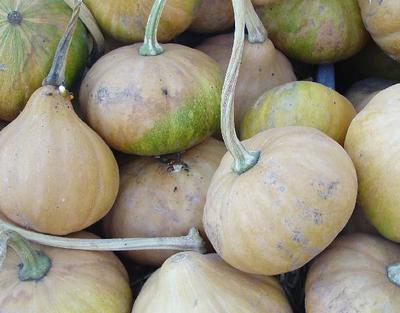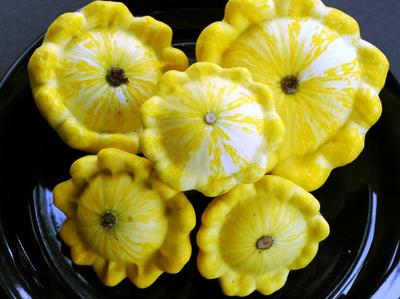2020 SEVG recommends: Apply 1 to 2 lb boron (B) per acre (1 Tbsp/100? row.) with broadcast fertilizer for almost all of our vegetables. See TABLE 2. GENERAL FERTILIZER SUGGESTIONS FOR VEGETABLE CROPS starting on page 6. Given the plan to only fertilize the veggies and not the weeds in between, apply it at 1 Tbsp/100 ft. row.
Basil
Prospera® DMR (CG1)Organic (F1) Basil Seed from Johnny’s. First try for us.
- Fast-growing, classic Genovese basil with downy mildew and Fusarium resistance. Disease Resistance Codes DM and F.
- Transplant: Sow indoors 6 weeks prior to setting out. Plant 1/4″ deep and keep at 70°F (21°C) for best germination. Transplant to the field when seedlings have 3-4 sets of leaves, spacing at 4-8″ apart in rows 18″ apart.
Brocolli
- Min Temperature—Optimal Temp—Max Soil Temp: 45°—60° to 85°—95° per Johnny’s spreadsheet.
- Add Boron to the row at 1 Tbsp/100 ft row applied as 1 tsp in a 2-gallon watering can and the 2 gallons sprinkled along the 30-foot long row.
- Soak the seeds in warm water overnight
- Green Magic Broccoli came up fine and produced nice 4 in. to 5 in. heads in 2020 & 2021. Best producer and should plant again.
- 100 seeds per packet at 12 in. oc transplants = max 100 ft. row
- Planting Depth: 1/4 in.
- Seed Spacing: 12 in.
- Thin to 18-24 inches
- Days to Maturity: 55
- Disease Resistance: Downy Mildew
Cabbage, Spring
- Optimal Sowing Date—Optimal Soil Temperature—Max Temperature – 9/1—85°—95° per Johnny’s spreadsheet.
- Cheers Cabbage (100 seeds per packet) provides exceptional disease resistance and consistent production. This hybrid cabbage variety is resistant to fusarium yellows and black rot. From Hoss here
- Planting Depth: 1/4 in.
- Seed Spacing: 12 in.
- Row Spacing: 2-3 ft.
- Days to Maturity: 75
- 100 seeds per packet at 12 in. oc = 100 ft. row
- Cabbage are heavy feeders and require a considerable amount of nitrogen for larger heads. For best results, inject or soil drench with a balanced fertilizer at least once every two weeks.
Cantaloupe
- Hales Best 45 – Seeds left over from 2021.
- 2 to 3 plants per hill in hills spaced 4 to 6 feet apart, or 1 to 2 feet apart in rows 5 feet apart.
- Germination Temps – Min 60°, Optimum 75-95°
- Sugar Cube (F1) Melon Seed – From Johnny’s – First try for us.
- Strong disease package and long harvest window. Well-suited for northern and southern regions. Harvest at full-slip (when a gentle tug removes the fruit from the vine). High resistance to Fusarium wilt races 0–2, powdery mildew, and watermelon mosaic virus; intermediate resistance to papaya ringspot virus and zucchini yellow mosaic virus.
- DIRECT SEEDING: Sow 1-2 weeks after last frost when soil is warm, above 70°F (21°C), 3 seeds every 18″, 1/2″ deep, thinning to 1 plant/cell or pot.
- Protect against cucumber beetles with insecticides such as pyrethrin or azadirachtin.
- DISEASE RESISTANCE CODES – F, PM, WMV, PRSV, ZYMV
Chard, Swiss
- Green Lucullus is possibly the most common and well known Swiss Chard. Originally an Italian heirloom variety, it has dark green leaves and white, crisp stalks. This is a nice variety if you live in a hot area because it’s more heat tolerant than some other types. Bought two 1.5 oz. packets from St. Elmo F&S Oct. 10, 2020.
- Germination Temps – Min 40° and Optimum 85°
- To speed up germination, soak seeds in water for 24 hours before planting.
- Planting depth: 1/2 inch
- Seed spacing: 2 to 6 inches
- Spacing between rows: 18-24 inches
- Days to germination: 7-14
- Spacing after thinning: 8-12 inches
- Days to maturity: 52
Corn
- G90 seeds leftover from 2021.
- last year sowed on March 20th.
Cucumber
- General Advice – From SESE.
- Seeds require a temperature of at least 68 degrees F to germinate. – In 2021 we had good germination with night time lows in the mid 50° range.
- Final spacing should be 6-12 in. apart in rows 3-5 ft. apart.
- ‘Ashley’ is an early variety with productive vines and dark green fruit that are seven to eight inches long, tapered on the stem end. An excellent slicing variety. Bred and released by the South Carolina Truck Experimental Station, Charleston in 1956. ‘Ashley’ is resistant to downy mildew and does well in humid areas. Each packet contains one gram, which is approximately 25 to 30 seeds. Bought from Hurley F&F.
- Wisconson SMR-58 Cucumber – For planting them in a hill, place three seedlings or 7-8 seeds in each hill; space hills 4-5? apart. If rows are preferrable, plant seedlings 1? apart or place 5 seeds within 1? and later thin them. Cucumbers love heat and cannot endure even a light frost; if cold temperatures threaten, cover the seedlings.
Okra – Red Burgundy seeds saved from last year.
Germination Temps – Min 60° and Optimum 85-95°
Okra Suggestions from The Old Farmer’s Almanac
- Side-dress the plants with 10-10-10, aged manure, or rich compost (1/2 pound per 25 feet of row). You could also apply a balanced liquid fertilizer monthly. Avoid too much nitrogen, which deters flowering and encourages leafy growth. Learn more about soil amendments and preparing soil for planting.
- High heat can slow the growth of okra.
- Prune the tops of okra plants when they reach 5 to 6 feet tall. This will result in more side branches. Prune those as needed.
- In warm regions, some growers cut plants to about 2 feet when productivity slows in summer. The plants grow back and produce another crop of okra.
- After the first harvest, remove the plant’s lower leaves to help speed up production.
Peas
- Mississippi Silver Crowder
- Mississippi Purple Crowder
- Top Pick
- Germination temp 65-75°
Peppers
- Cayenne, Long Red Hot Pepper from SESE. Did great in 2020.
- Cayenne, Carolina Hot Pepper
- Carolina Wonder Sweet Bell Pepper
- Everman Jalapeno Pepper – Everman is an extra large (1¾”W x 4”L), thick walled jalapeño with excellent weight and shelf life. Its attractive fruit are a shiny, deep green with almost no cracking. Vigorous plants have continuous set and high resistance to BLS. A great choice for fresh market sales.
- Soil temperature: 75 – 80 degrees fahrenheit
- Seeding depth: 0.25 – 0.5 inches
- Germination days: 10 – 20 days
- Grow on temperature day: 60 – 65 degrees fahrenheit
- Weeks indoor: 6 – 8 weeks
- Plant type: annual
- Maturation days: 75 days
Summer Squash
- Goldprize Squash from HOSS has more disease resistance.
- Delta seed leftover from last year when it did well…but poor germination this year.
- Golden Bush Scallop Summer Squash from SESE.
- Germination Temp – Min 65, Optimum 85-95°
- Planting Depth: 1/2 in.
- Seed Spacing: 18-24 in
- Row Spacing: 5-6 ft
- Days to Maturity: 50
- Disease Resistance: Watermelon Mosaic Virus, Zucchini Yellow Mosaic Virus
- Seed grown and stewarded by Twin Oaks Seed Farm in Louisa, VA.
Dunja Zucchini Squash from Harris
- Seeding depth: 1 – 1.5 inches
- Germination days: 6 – 12 days
- Maturation days: 45 days
- Seeds left from 2021.
Winter Squash – Moschatas
Seminole Pumpkin/Squash

From SESE – (C. moschata) Keeps up to 1 year at room temperature! Small fruits are sweeter than Butternut and have firm, deep-orange flesh. Large vines bear bell-shaped buff-colored fruits averaging 6 in. in diameter. Resistant to vine borers. Excellent Downy Mildew resistance; a good choice for hot, humid, disease-prone areas. Give it ample water and room to roam. Also good as a summer squash when picked young.
Squash Autumn Frost F1 Seed

25 Seeds ordered from Harris, 11/28/2021
Uniquely ribbed, round fruit ripens to dark tan with a frosted overlay. The flesh is similar to butternut with superior flavor, quality, and storage of up to 4 months. Prepare by cutting lengthwise for roasting or cut the top 2″ to stuff and bake upright. Intermediate resistance to Powdery Mildew. Fruits grow to 6 inches wide per Territorial Seeds.
Squash Honeynut

From Harris Seed – This specialty butternut squash comes from Cornell University’s Breeding Institute. Honeynut produces mini butternut squash on a semi-vining type plant. The 5″ long fruit weigh from 1 to 1-1/2 lbs. and have a sweet and rich flavored deep orange flesh. The rind starts off a dark green, turns tan and then a rich burnt orange color at full maturity. Intermediate resistance to powdery mildew. Plant as early as possible due to long maturity.
- Seeding depth: 1 – 1.5 inches
- Germination days: 6 – 12 days
- Maturation days: 110 days



